¿Está pensando en trasladar su sitio de WordPress a una nueva empresa de alojamiento o a un servidor diferente?
El mayor riesgo al cambiar de alojamiento web o migrar un sitio web a un nuevo servidor es la pérdida de datos y el tiempo de inactividad.
En este tutorial paso a paso, le mostraremos cómo migrar su sitio de WordPress a un nuevo alojamiento de forma segura y sin tiempo de inactividad. También responderemos a las preguntas más frecuentes acerca de cómo trasladar un sitio WordPress a un nuevo proveedor de alojamiento.
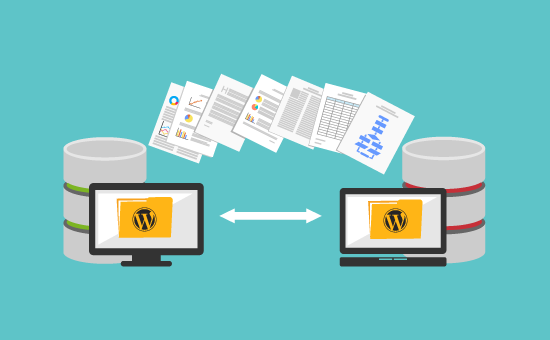
Importante: Antes de empezar, queremos que sepas que muchas empresas de alojamiento de WordPress ofrecen un servicio de migración gratuito. Puede que no aparezca en su sitio web, así que lo único que tienes que hacer es preguntar. Por lo general, es gratuito, pero algunas pueden cobrar una pequeña cuota.
Dicho esto, veamos los pasos que vamos a seguir para trasladar WordPress a un nuevo servidor de alojamiento (sin tiempo de inactividad):
¿Preparados? Primeros pasos.
Paso 1: Elija su nuevo alojamiento para WordPress
Si usted está atascado con un alojamiento web lento, incluso después de optimizar la velocidad y el rendimiento de WordPress, entonces es el momento de mover su sitio de WordPress a un nuevo alojamiento que puede manejar su creciente tráfico.
A la hora de buscar un nuevo proveedor de alojamiento para WordPress, es importante elegir con cuidado para no tener que mudarse de nuevo en un futuro próximo.
Éstos son los que recomendamos:
- Para un alojamiento compartido fiable, recomendamos Bluehost. Están oficialmente recomendados por WordPress.org. Usando nuestro cupón Bluehost, los usuarios de WPBeginner obtienen hasta un 61% de descuento y un nombre de dominio gratis.
- Para un alojamiento compartido más rápido, recomendamos Hostinger. Se encuentran entre las mejores empresas de alojamiento de WordPress y ofrecen servidores más rápidos con un excelente soporte al cliente.
- Si está buscando alojamiento en la nube o proveedores de ubicación específica, le recomendamos que marque / compruebe SiteGround. Tienen centros de datos en tres continentes diferentes.
- Si está buscando alojamiento gestionado para WordPress, le recomendamos que marque / compruebe WP Engine. Es el mejor y más conocido proveedor del sector.
Después de comprar su nuevo alojamiento, NO instale WordPress. Lo haremos en un paso posterior.
Por ahora, su nueva cuenta de alojamiento web debe estar vacía, sin archivos ni carpetas en su directorio principal.
Paso 2: Establecer Duplicator para facilitar la migración
Lo primero que debe hacer es instalar y activar el plugin Duplicator en el sitio web que desea trasladar. Para más detalles, consulta nuestra guía paso a paso sobre cómo instalar un plugin de WordPress.
Duplicator es el mejor plugin de migración de WordPress del mercado. También viene con copias de seguridad programadas automatizadas, soporte de almacenamiento en la nube, restauración en 1 clic y migraciones inteligentes.
Nota: Duplicator también tiene una versión gratuita llamada Duplicator Lite. Se puede utilizar para mover su sitio web, pero tiene características limitadas en comparación con la versión pro.
Una vez que haya instalado y activado Duplicator, vaya a la página Duplicator ” Paquetes en su área de administrador de WordPress.
A continuación, debe hacer clic en el botón “Crear nuevo” de la esquina superior derecha.
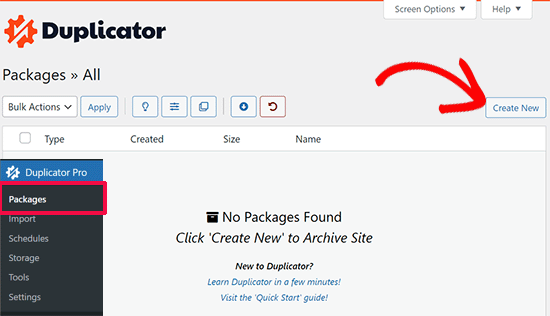
Esto iniciará el asistente de copia de seguridad de Duplicator.
En la pantalla siguiente, puede indicar un nombre para la copia de seguridad o simplemente hacer clic en el botón “Siguiente” para continuar.

A continuación, Duplicator explorará su sistema para asegurarse de que todo está en orden para preparar el paquete.
Asegúrese de que los resultados de su exploración son correctos (todo debe indicar “Bien”) y, a continuación, haga clic en el botón “Crear”.
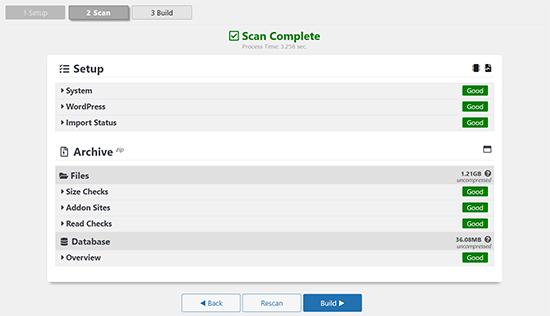
El proceso puede tardar varios minutos en completarse, así que deja la pestaña abierta mientras el plugin hace su trabajo.
Una vez finalizado el proceso, verás opciones de descarga para el instalador y el paquete de archivos. Debes hacer clic en el botón “Descargar” y seleccionar “Ambos archivos”.

El archivo de almacenamiento es una copia de su sitio web completo, y el archivo de instalación automatizará el proceso de instalación por usted.
Paso 3: Importe su sitio WordPress al nuevo alojamiento
Ahora que ya has descargado tanto el archivo como el instalador, el siguiente paso es subirlos a tu nuevo alojamiento web.
Para ello, conéctese a su nuevo alojamiento web mediante FTP.
Si nunca lo has hecho, consulta nuestra guía para principiantes sobre cómo subir archivos a WordPress mediante FTP.
Normalmente, introducirías el nombre de dominio de tu sitio web como alojamiento al conectar tu cliente FTP.
Sin embargo, como tu nombre de dominio sigue apuntando a tu antiguo host, tendrás que conectarte introduciendo la dirección IP o el nombre de host de tu servidor.
Encontrará esta información en el Escritorio del panel de control de su nueva cuenta de alojamiento.
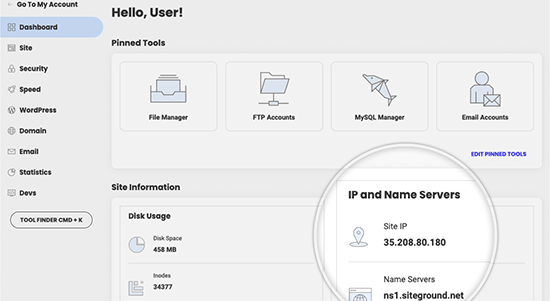
Si no se ha podido encontrar esta información, se puede pedir soporte a la nueva empresa de alojamiento web, y ellos le ayudarán.
Utilizando el cliente FTP, debe subir tanto el archivo installer.php como el archivo .zip al directorio raíz de su sitio web.
Suele ser la carpeta /username/public_html/.
De nuevo, si no está seguro, pregunte a su empresa de alojamiento web.
Asegúrese de que su directorio raíz está completamente vacío. Algunas empresas de alojamiento web instalan WordPress automáticamente cuando te registras.
Si tienes WordPress instalado en tu directorio raíz, entonces necesitas borrar WordPress primero.
Una vez hecho esto, deberá subir tanto el archivo zip como el archivo installer.php al directorio raíz de su sitio.
Paso 4: Cambiar el archivo de alojamiento para evitar tiempos de inactividad
Una vez que hayas subido ambos archivos a tu nuevo host, tienes que acceder al archivo installer.php en un navegador.
Normalmente, se puede acceder a este archivo utilizando una URL como ésta:
http://www.example.com/installer.php
Sin embargo, esta URL le llevará a su antiguo alojamiento web, y obtendrá un error 404. Esto se debe a que su nombre de dominio sigue apuntando a su antiguo alojamiento web.
Normalmente, otros tutoriales te dirán que cambies los servidores de nombres de tu dominio y lo apuntes a tu nueva empresa de alojamiento, pero eso es un error.
Si lo hace ahora, sus visitantes verán un sitio web roto cuando lo migre.
Le mostraremos cómo puede acceder temporalmente a su nuevo sitio en su ordenador sin que ello afecte a su antiguo sitio.
Esto se hace con el archivo de alojamiento de su ordenador.
El archivo de alojamiento puede utilizarse para asignar nombres de dominio a direcciones IP concretas. En otras palabras, le permite engañar a su ordenador para que piense que el sitio web se ha trasladado aunque no sea así.
Veamos cómo añadir una entrada para su nombre de dominio en el archivo de hosts para que apunte a su nueva empresa de alojamiento.
Estos cambios le permitirán acceder a los archivos de su nuevo alojamiento utilizando su propio nombre de dominio, mientras que el resto del mundo seguirá accediendo a su sitio desde el antiguo alojamiento. Esto garantiza un tiempo de actividad del 100%.
Lo primero que debe hacer es encontrar la dirección IP de su nuevo servidor de alojamiento web.
Para encontrarlo, necesita acceder a su Escritorio de cPanel y hacer clic en el enlace de expandir estadísticas en la barra lateral izquierda. La dirección de su servidor aparecerá como “Dirección IP compartida”.
Por ejemplo, en Hostinger, encontrará la dirección IP de su servidor en los detalles de su plan de alojamiento.
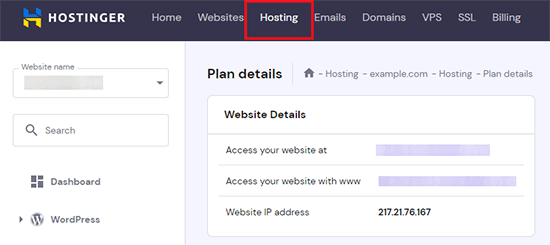
Si utiliza un PC con Windows, deberá abrir la aplicación Bloc de notas con privilegios de administrador.
Basta con hacer clic en el botón “Inicio” y buscar la aplicación Bloc de notas. Haga clic con el botón derecho en el icono de la aplicación Bloc de notas y seleccione “Ejecutar como administrador”.
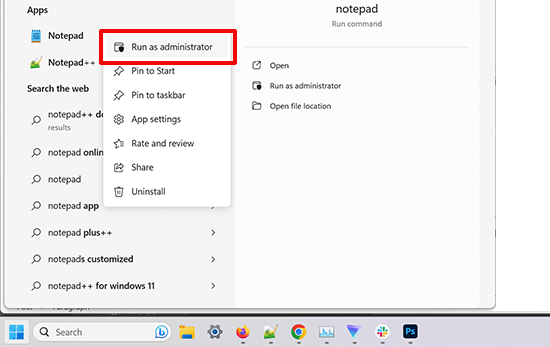
Aparecerá una indicación de UAC de Windows y deberá hacer clic en “Sí” para iniciar el Bloc de notas con privilegios de administrador.
En la pantalla Bloc de notas, vaya a Archivo ” Abrir y, a continuación, vaya a la carpeta C:\Windows\System32\drivers\etc. Desde esta carpeta, seleccione el archivo de alojamiento y abrirlo.
Si utiliza un Mac, deberá abrir la aplicación Terminal e introducir este comando para editar el archivo hosts:
sudo nano /private/etc/hosts
Tanto para usuarios de Windows como de Mac, en la parte inferior del archivo de alojamiento, debe introducir la dirección IP que ha copiado y, a continuación, el nombre de su dominio. Así:
192.168.1.22 www.example.com
Asegúrese de sustituir la dirección IP por la que copió de cPanel y example.com por su propio nombre de dominio.
Cuando hayas terminado, guarda los cambios.
Ahora puede acceder a sus archivos en el nuevo alojamiento utilizando su nombre de dominio en su ordenador.
Importante: No olvide deshacer los cambios realizados en el archivo de alojamiento una vez finalizada la migración (paso 6).
Paso 5: Creación de la base de datos MySQL en su nuevo alojamiento
Antes de ejecutar el instalador en el nuevo alojamiento, tendrá que crear una base de datos MySQL en su nueva cuenta de alojamiento. Si ya has creado una base de datos MySQL, entonces puedes saltar al siguiente paso.
Crear una base de datos en cPanel
Vaya al Escritorio cPanel de su nueva cuenta de alojamiento, desplácese hasta la sección Bases de datos y haga clic en el icono “Bases de datos MySQL”.
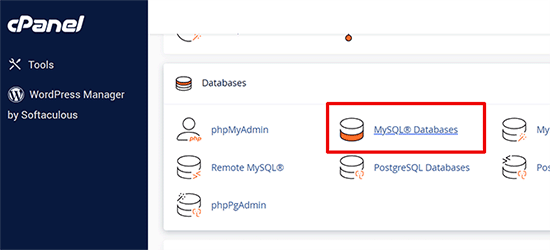
Verá un campo para crear una nueva base de datos.
Introduzca un nombre para la base de datos y haga clic en el botón “Crear base de datos”.

Después de crear la base de datos MySQL, debe desplazarse hasta la sección Usuarios MySQL.
A continuación, introduzca un nombre de usuario y una contraseña para su nuevo usuario y haga clic en el botón “Crear usuario”.

Después, tienes que añadir este usuario a tu base de datos. Esto le dará al nombre de usuario que acabas de crear todos los permisos para trabajar en esa base de datos.
Para ello, desplácese hasta la sección “Añadir usuario a una base de datos”. Simplemente seleccione el usuario de la base de datos que ha creado en el menú desplegable situado al lado del usuario, luego seleccione la base de datos y haga clic en el botón ‘Añadir’.
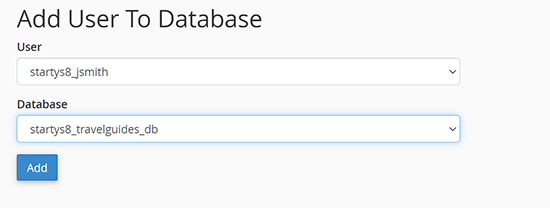
Su base de datos ya está lista para ser utilizada con WordPress. Asegúrese de anotar el nombre de la base de datos, el nombre de usuario y la contraseña. Necesitará esa información en el siguiente paso.
Paso 6: Iniciar el proceso de migración de la duplicadora
Ahora, estamos listos para ejecutar el instalador. Navegue hasta la siguiente dirección en la ventana de su navegador, sustituyendo ejemplo.com por su nombre de dominio:
http://www.example.com/installer.php
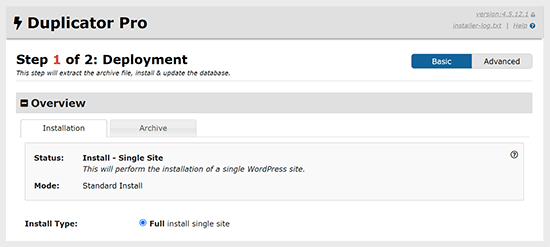
El instalador ejecutará unas cuantas pruebas y le mostrará ‘Aprobado’ a continuación de las pruebas de archivo y validación.
Debe marcar / comprobar la casilla de verificación de los términos y condiciones y continuar haciendo clic en el botón “Siguiente”.
Ahora, se le pedirá que introduzca su alojamiento MySQL, el nombre de la base de datos, el nombre de usuario y la contraseña.
Su alojamiento será probablemente localhost. A continuación, introduzca los datos de la base de datos creada en el paso anterior.
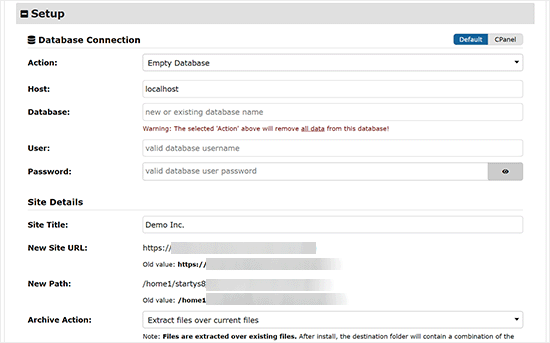
A continuación, el Duplicador debe marcar / comprobar que puede conectarse a la base de datos y que puede ejecutar la instalación.
Haga clic en el botón “Validar” de la parte inferior para continuar.

Si Duplicator puede conectarse, verá los resultados de la prueba como Pass.
Ahora puede marcar / comprobar la casilla de verificación de las condiciones y avisos y hacer clic en el botón “Siguiente”.
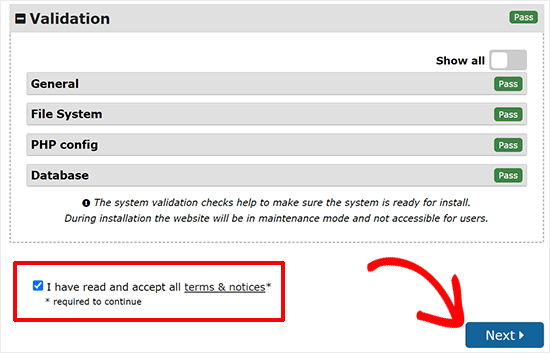
Haga clic en el botón “Siguiente” para continuar.
Duplicator importará su base de datos de WordPress desde el archivo zip a su nueva base de datos.
A continuación, le pedirá que actualice la URL o ruta del sitio. Como no va a cambiar los nombres de dominio, NO necesita cambiar nada aquí.
Basta con hacer clic en el botón “Siguiente” para continuar.
Duplicator ejecutará los pasos finales y le mostrará el botón de acceso.

Ahora puede acceder a su sitio de WordPress en el nuevo alojamiento para asegurarse de que todo funciona según lo previsto.
Paso 7: Actualice sus servidores de nombres de dominio (DNS)
En este punto, has creado una copia completa de tu base de datos y archivos de WordPress en tu nuevo servidor de alojamiento, pero tu dominio todavía apunta a tu antigua cuenta de alojamiento web.
Para actualizar su dominio, debe cambiar los servidores de nombres DNS. Esto garantiza que los usuarios accedan a la nueva ubicación de su sitio web cuando escriban su dominio en sus navegadores / exploradores.
Si registró su dominio con su proveedor de alojamiento, lo mejor es transferir el dominio a un nuevo alojamiento.
Por otro lado, si utiliza un registrador de dominios como Domain.com, GoDaddy o Network Solutions, deberá actualizar sus servidores de nombres.
Necesitará la información del servidor de nombres DNS de su nuevo alojamiento web. Suelen ser un par de URL con el siguiente aspecto:
ns1.hostname.comns2.hostname.com
Por el bien de esta guía, le mostraremos cómo cambiar los servidores de nombres DNS con GoDaddy.
Para otros proveedores de alojamiento, consulte nuestra guía sobre cómo cambiar los servidores de nombres de dominio.
Dependiendo de su registrador de dominios o alojamiento web, las capturas de pantalla pueden tener un aspecto diferente. Sin embargo, el concepto básico es el mismo.
Debe buscar el área de gestión de dominios y, a continuación, buscar los servidores de nombres. Si necesita ayuda para actualizar los servidores de nombres, puede solicitarla a su empresa de alojamiento web.
Para GoDaddy, tienes que acceder a tu cuenta de GoDaddy y luego hacer clic en “Dominios”.
A continuación, haga clic en el botón “Gestionar” situado junto al nombre de dominio que desea modificar.

Vaya a la sección “Ajustes adicionales”.
A continuación, deberá hacer clic en “Gestionar DNS” para continuar.

A continuación, desplácese hasta la sección “Servidores de nombres”.
Aquí, haga clic en el botón “Cambiar”.

En primer lugar, deberá cambiar el desplegable de tipo de servidor de nombres de “Predeterminado” a “Personalizado”.
A continuación, puede introducir los datos de su nuevo proveedor de alojamiento en Servidores de nombres.
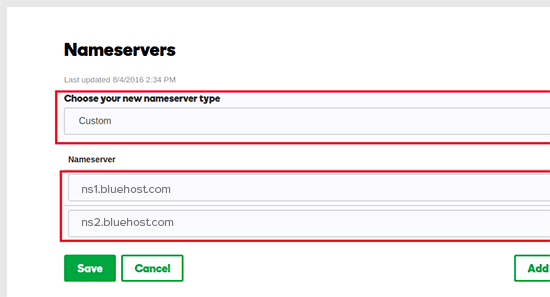
No olvides hacer clic en el botón “Guardar” para almacenar los cambios.
Ha cambiado correctamente los servidores de nombres de su dominio. Los cambios de DNS pueden tardar entre 4 y 48 horas en propagarse a todos los usuarios.
Dado que tiene el mismo contenido en su antiguo host y en el nuevo, sus usuarios no verán ninguna diferencia. La migración de WordPress será perfecta y sin ningún tiempo de inactividad.
Para mayor seguridad, le recomendamos que no cancele su antigua cuenta de alojamiento hasta 7 días después de la migración.
Preguntas frecuentes
Estas son algunas de las preguntas que se hacen muchos de nuestros usuarios al trasladar WordPress de un alojamiento a otro.
1. ¿Cómo puedo migrar mi sitio web WordPress a otro alojamiento?
Puede migrar su sitio web de WordPress trasladando los archivos y la base de datos de WordPress de su antiguo alojamiento al nuevo proveedor de alojamiento.
Algunas empresas de alojamiento también ofrecen servicios gratuitos de transferencia de sitios web, pero tendrás que preguntarles. También puedes hacerlo tú mismo transfiriendo archivos mediante un cliente FTP e importando la base de datos a través de phpMyAdmin.
2. ¿Puedo migrar mi sitio WordPress a otro proveedor de alojamiento?
Sí, puedes migrar tu sitio WordPress a otro proveedor de alojamiento.
3. ¿Puedo acceder a la nueva cuenta de alojamiento sin registrar un nombre de dominio?
Sí, puede acceder a una cuenta de alojamiento sin registrar un nombre de dominio.
El nombre de dominio y el alojamiento son dos servicios diferentes, y no es necesario registrar un nombre de dominio al darse de alta en un nuevo alojamiento. Para más detalles, consulta nuestra guía sobre la diferencia entre nombre de dominio y alojamiento web.
Algunos proveedores de alojamiento le pedirán que seleccione un nombre de dominio como primer paso al contratar el alojamiento. También te permitirán introducir un nombre de dominio si ya tienes uno.
4. ¿Tengo que transferir mi nombre de dominio al nuevo alojamiento?
No, no es necesario que transfiera su nombre de dominio al nuevo alojamiento. Sin embargo, la transferencia de su nombre de dominio a su nuevo alojamiento hará que sea más fácil de renovar y gestionar en el mismo tablero de instrumentos como su nueva cuenta de alojamiento.
Para más información sobre este debate, consulte nuestra guía definitiva sobre nombres de dominio y su funcionamiento.
5. ¿Cómo corregir el error de conexión a la base de datos en Duplicator?
Si aparece un error de conexión a la base de datos o un error de conexión a la base de datos en Duplicator, es probable que haya introducido información incorrecta para la conexión a la base de datos.
Asegúrese de que el nombre de la base de datos, el nombre de usuario de MySQL y la contraseña son correctos. Algunas empresas de alojamiento web no utilizan localhost como host para sus servidores MySQL. Si este es el caso, tendrá que pedir al personal de soporte de su alojamiento web que le proporcione la información correcta.
6. ¿Cómo puedo marcar / comprobar si mi sitio web se está cargando desde el nuevo alojamiento?
Hay varias herramientas en línea que le permiten ver quién aloja un sitio web. Una vez que haya transferido su sitio web al nuevo alojamiento, puede utilizar cualquiera de estas herramientas, y le mostrarán el nombre de la empresa de alojamiento web que aloja su sitio web.
Si no ha pasado mucho tiempo desde que migró su sitio web e hizo cambios en su servidor de nombres de dominio (DNS), es probable que su sitio aún se cargue desde su antiguo alojamiento. Los cambios de nombre de dominio pueden tardar hasta 48 horas en propagarse por completo.
7. ¿Tengo que borrar algún archivo o dato del antiguo alojamiento?
Cuando cambie de empresa de alojamiento, le recomendamos que conserve su antiguo sitio web durante al menos una semana. Después, puede borrar los archivos de su antiguo alojamiento web. Si cancelas tu cuenta, tu proveedor de alojamiento web borrará todos tus datos de acuerdo con su política.
8. ¿Cuánto tiempo debo mantener activa mi cuenta en el antiguo alojamiento?
Una vez que haya migrado su sitio web al nuevo alojamiento, y si no tiene ningún otro sitio web alojado con su antiguo alojamiento web, puede cancelar su antigua cuenta de alojamiento web.
Sin embargo, en algunos casos, es posible que ya les hayas pagado por el alojamiento anual. Deberías comprobar su política de reembolso para ver si tienes derecho a algún reembolso en caso de cancelación.
9. ¿Cómo traslado un sitio WordPress con SSL/HTTPS?
Deberá instalar un certificado SSL en su nuevo proveedor de alojamiento. Después de eso, puede seguir los mismos pasos mencionados anteriormente. Sólo asegúrese de que utiliza HTTPS en las URL, como https://example.com
10. Bonificación: Migración gratuita del sitio por su nuevo alojamiento
Si desea cambiar su alojamiento web, pero los pasos anteriores le parecen demasiado complicados, puede elegir los siguientes proveedores, que migrarán su sitio web por usted.
SiteGround, Hostinger y WP Engine ofrecen migración gratuita de sitios web para los usuarios de WPBeginner.
Esperamos que esta guía paso a paso te haya ayudado a trasladar WordPress a tu nuevo alojamiento sin ningún tiempo de inactividad. Si tienes algún problema con la migración de WordPress, marca / comprueba nuestra guía sobre los errores más comunes de WordPress y cómo corregirlos.
If you liked this article, then please subscribe to our YouTube Channel for WordPress video tutorials. You can also find us on Twitter and Facebook.





Syed Balkhi says
Hey WPBeginner readers,
Did you know you can win exciting prizes by commenting on WPBeginner?
Every month, our top blog commenters will win HUGE rewards, including premium WordPress plugin licenses and cash prizes.
You can get more details about the contest from here.
Start sharing your thoughts below to stand a chance to win!
Moinuddin Waheed says
Hands down the best guide for migrating a website from one host to another without any downtime.
I used to think it’s impossible to do without having some lag but no, it’s possible and with easy to follow steps.
Thanks wpbeginner for this detailed guide. I need to do this very often and had no clue that it can be done with no compromise on website downtime.
THANKGOD JONATHAN says
Thank you for the helpful article.
But how about someone who wants to migrate his reseller hosting to a new reseller account and want to move all his clients websites to the new host? Do you have any article for that? I will really apprecite it.
WPBeginner Support says
We do not have a specific article for bulk movement at the moment but if you reach out to the hosting provider they may have a tool to assist.
Administrador
Jiří Vaněk says
The best practice that has proven successful for me:
Download data from FTP.
Create a database dump.
Upload both to the new server.
Test functionality using the HOSTS file.
Switch DNS.
An efficient, functional, and quick method for migrating WordPress to another server.
AC says
Hello,
I have built a new website on a subdomain using we’ll call it hosting server A, could I also use this process to move that website to a new hosting server (B) and update the path to the new domain (noted in step 6), if the new domain is already connected to a live wordpress site on an entirely different server (C)?
Or would I be better to move current website from server C to server B exactly as you have outlined above and get that going, then copy the files from updated website on server A to current hosting server B? Hope that makes sense. Just want the most seamless approach!
For a little bit of an explanation… Business has a website that needs updating that is hosted with another company, I have built the “new” website on my own subdomain. Business owns domain, and wants new website to live on new hosting that they control under same account as domain for easier access to everything moving forward.
WPBeginner Support says
Either method can work, if you are already updating the site then you would want to use the first method and move the new site then update the domain to point toward the correct hosting provider to prevent you from having to do extra work on a live site.
Administrador
D Lewis says
Another great tutorial, WPBeginner!
Is this the same process used for simply downloading a WordPress.org blog from an old computer onto another one (keeping the same hosting company)?
Thank you,
D Lewis
WPBeginner Support says
If you are keeping the same host you can normally check with your hosting provider to have them change it to the new server. If they do not offer this then changing your hosts file will likely not work but the other steps would be the same.
Administrador
lse says
Do you find it better to create a fresh install of WordPress latest and migrate to this my existing WordPress website – import – data only, rather than the old WordPress – I update from 2011 – migrate all files/data/database, and Not create a fresh install…?
WPBeginner Support says
It would depend on how you want the site’s content. If you are looking to do major changes to the site then creating a new site and importing the content would be good. This guide is for reducing downtime and keeping the site the same which is why we recommend importing all of the files and data.
Administrador
KubaP says
Cool. Best tutorial. Works like gem in 2023! I’ve done my first smooth migration with the help of this awesome article
WPBeginner Support says
Glad our guide was helpful!
Administrador
Darda says
Thank you so much for this tutorial! It works great!
WPBeginner Support says
Glad our guide was helpful!
Administrador
Mr. Akhil says
I am in the stage of 2. it doesn’t show all good but “Size check notice” is not showing good result how can i solve it, what if some scanning process is not good ???
WPBeginner Support says
From the sound of the error, the plugin is warning you that you have a large site and it may have trouble depending on your host for exporting your content. It would depend on the specific error if you are seeing other errors for the steps to follow but the plugin’s support should be able to assist.
Administrador
Carlos Almazan says
Thank you very much for this tutorial, it´s amazing!
I would like to ask you if possible, what steps of this tutorial should I skip if I just want to duplicate the first website? In other words, i want to leave the first website as it is and just create a new one (a new copy) in an another hosting provider.
Thank you very much in advance!
Regards!
WPBeginner Support says
For that, we would recommend taking a look at our moving to a new domain article below and not doing the 301 redirects or notifying Google.
https://www.wpbeginner.com/wp-tutorials/how-to-properly-move-wordpress-to-a-new-domain-without-losing-seo/
Administrador
Emma says
Good day, thank you for this wonderful tutorial. Please how do i migrate to my new host and use the domain on my new host, without using the old host domain
WPBeginner Support says
For moving your site to a new domain, you would want to take a look at our guide on changing your domain below:
https://www.wpbeginner.com/wp-tutorials/how-to-properly-move-wordpress-to-a-new-domain-without-losing-seo/
Administrador
Emmanuel says
Good day, thank you for this wonderful tutorial. Please how do i migrate to my new host and use the domain on my new host, without using the old host domain
WPBeginner Support says
For moving your site to a new domain, you would want to take a look at our guide on changing your domain below:
https://www.wpbeginner.com/wp-tutorials/how-to-properly-move-wordpress-to-a-new-domain-without-losing-seo/
Administrador
Spear says
Thank you so much for the informative guide!
I’d like to know if possible, how long does it take to migrate wp project to the server?
Currently the files are in the same server and trying to install wp script via Softaculous.
thank you!
WPBeginner Support says
It would depend on how much content you had on your old site for how long it takes to transfer your content.
Administrador
Milan says
What will happen with my mailboxes on old host? How to manage this transfer and keep e-mails and related stuff?
WPBeginner Support says
That would depend on your hosting providers, some have the option to export your mailboxes and import them on the new host while others do not have the option. If you check with your hosting providers they would be able to let you know the options you have available.
Administrador
Mandy Steinhardt says
You are the MVP. Thanks for this guide, it worked!
WPBeginner Support says
Glad our guide was helpful
Administrador
Cristiano says
Hi! Thanks for this great tutorial.
I’ve moved 1 website and it was flawless.
I tried to move a 2nd website. The content folder was really heavy, so i excluded it from the duplicator. I moved these folder manually.
What I’ve noticed is that the new website is not loading any images.
How can I solve this?
Thanks in advanced.
WPBeginner Support says
You would likely want to check your folder permissions following our guide below:
https://www.wpbeginner.com/wp-tutorials/how-to-fix-image-upload-issue-in-wordpress/
Administrador
Adam says
Im having issues with the host file.
Changed it to the correct settings but still seeing the old host site,
Alex S says
Awesome, I did it perfectly. Thanks
Gimel says
Good day,
Does this also work for moving from localhost to an online hosting service?
WPBeginner Support says
For moving your site to a hosting provider from your local computer, you would want to follow our guide below:
https://www.wpbeginner.com/wp-tutorials/how-to-move-wordpress-from-local-server-to-live-site/
Administrador
Francis Caysip says
Do I need to change nameservers if the “new” web host is also the domain host?
WPBeginner Support says
If your domain already points to the new host then you would not need to change it, if the domain is pointing toward your old host it would need to be changed.
Administrador
Bryce says
Thank you for this very well-written tutorial! It helped me move from a hosting service that upped their prices so that I can get the newcomer discount with a new host. Thanks!
WPBeginner Support says
Glad our guide was helpful
Administrador
Jon says
Your article states that the new host folder must be empty before continuing on with the migration. How does this work for someone where I am migrating sites to a host that has other sites already on it?
WPBeginner Support says
your hosting provider would normally have a folder for each specific site and you would add your site to the empty folder.
Administrador
Andrea Crenshaw says
Real Lifesaving (Sitesaving) article! Thank you soo much!!
WPBeginner Support says
Glad you found our guide helpful
Administrador
Rousseau says
Thank you very much for this article! I just used it to switch hosting providers after getting tired of downtime with my old provider. Appreciate the great documentation.
WPBeginner Support says
Glad our guide was helpful
Administrador
Jacob says
Hi, I successfully transferred my website using the Duplicator plugin. Everything works, but now the website is running rather slowly. Is this a common side effect? Any suggestions for fixing this?
WPBeginner Support says
It is hard to say why your site may have slowed down, for a starting point we would recommend going through our guide below for speeding up your site first:
https://www.wpbeginner.com/wordpress-performance-speed/
Administrador
Binh says
Hello, Thanks for your guide.
1. I managed to the last steps but there are several issues in Database section, e.g. “DATABASE ERROR: database error write” -> is it common to get this error?
WPBeginner Support says
That sounds like you may have had an issue during the transfer process. You would want to reach out to your hosting provider to ensure they don’t see an error on their end.
Administrador
Rasif says
white transferring the site enter the database credentials screen an error showing.
“Error Processing Request an error occurred while testing the data base connection! Please try Again.”
WPBeginner Support says
You would want to ensure your database information is correct for one of the more common causes.
Administrador
Thomas says
Bluehost charges to migrate a website. Is that for the service or can I migrate it myself as above and not have to pay the fee??
WPBeginner Support says
The fee would be if you want them to do it for you. If you follow our guide above then it does not have a cost.
Administrador
Robert says
I will share my experience: for one case, I had to switch off the plugin responsible for SSL. Than it was possible to migrate the website correctly. Anyway, thank you for this tool! It is awesome!!
WPBeginner Support says
Glad it was helpful and thanks for sharing the workaround you used if someone else runs into that issue
Administrador
Ranjit Singh says
Stuck in step 6 after trying to open the installer.php getting privacy error message in chrome
“Your connection is not private
Attackers might be trying to steal your information from site (for example, passwords, messages, or credit cards). Learn more
NET::ERR_CERT_COMMON_NAME_INVALID”
WPBeginner Support says
Reach out to your hosting provider to ensure you have your SSL certificate set up correctly.
Administrador
Gordon says
This was a great step to step and helped me migrate a site when another plug-in failed on me. Thanks for your guidance!
WPBeginner Support says
Glad our guide was helpful
Administrador
Ryan says
stuck on step 4 I updated the notepad etc host doc but now how do I access the installer.php file? I tried typing in example.com/installer.php with my domain name into browser with no luck. I have saved the duplicator installer.php file into the www folder in the new hosting files.
WPBeginner Support says
You may want to check with your hosting provider to ensure there isn’t an issue with the location of the folder or if the folder was set under a different domain.
Administrador
Grace says
Hi! I’m stuck at Step 6/ I really need help. I uploaded the installer and .daf file in the correct root folder but still experiencing the 404 Not Found Error. I don’t know what to do next.
WPBeginner Support says
You would want to reach out to your hosting provider to ensure you’ve placed the file in the correct location.
Administrador
Nic says
I get an error on Step 1: Deployment:
Service Unavailable
The server is temporarily unable to service your request due to maintenance downtime or capacity problems. Please try again later.
WPBeginner Support says
You would want to reach out to your hosting provider for assistance. We have an article covering the different reasons for that error that you can take a look at below:
https://www.wpbeginner.com/wp-tutorials/how-to-fix-503-service-unavailable-error-in-wordpress/
Administrador
Chris says
Hi, thank you for this guide.
I was thinking you might need to add on the “nameserver” part that when migrating to a new web host is complete it is not necessary to change the but you need to change the A records to point the IP address of your new web host from your domain registration account settings. thank you and more power!
WPBeginner Support says
While that is an option it is not the most beginner-friendly and can cause confusion later for some users which is why we recommend the nameserver change at the moment.
Administrador
Jossif G says
Great write up and direction. I had couple from web, but yours is by far the best.
You provided a lot of details that no one does, like prepare cpanel files before installing. It help me a lot, thank you very much
WPBeginner Support says
Glad our guide was helpful
Administrador
Jumadi says
This guide is really helpful, you save me a lot buddy.. Thank you so much..
WPBeginner Support says
Glad our guide was helpful
Administrador
Vineesh says
Awesome post.
Worked out Well.
thanks guys….
WPBeginner Support says
You’re welcome, glad you found our content helpful
Administrador
Sebastian says
Thanks, simple and easy
WPBeginner Support says
You’re welcome
Administrador
Peace Ronny says
Can you transfer your project via USB
WPBeginner Support says
You would need physical access to your hosting provider’s service to do that.
Administrador
Dileepa K. says
Nice Article and very helpful
WPBeginner Support says
Glad you found our guide helpful
Administrador
Jack says
Thanks for this but im still confused, I am using a CDN and the DNS are pointing to the it, should i first pause the CDN or can still do the process ignoring it then i wont have to update the NS? How should i do it right with no downtime?
WPBeginner Support says
You can still follow this guide. When changing where your namservers are pointing you would update where your CDN is pointing rather than your nameservers.
Administrador
Abdulkarim says
Thank you, it helps me a lot,
Best regards,
WPBeginner Support says
You’re welcome
Administrador
Jeff Cole says
Lovely clear instructions, moved site over easily. My old host site I could access with or without the WWW , after the change over and before changing the nameserver I could access new site in host file with WWW and the old site without WWW. Thanks
WPBeginner Support says
You would want to reach out to your hosting provider to ensure your nameserver change was set up and that you don’t still have your hosts file changed.
Administrador
Zaeem Khan says
I want to change both the domain name and the hosting without losing site data and visitors
WPBeginner Support says
You would want to take a look at our guide below:
https://www.wpbeginner.com/wp-tutorials/how-to-properly-move-wordpress-to-a-new-domain-without-losing-seo/
Administrador
Faisal says
What if I have a website already on my new web host? If I upload the backup files (installer.php and the zip file) to a new folder in the root directory, how can I run the php file?
WPBeginner Support says
It would depend on the specific host, most you should be able to update your hosts file to be able to visit the page while others you can also set the new site on a temporary address.
Administrador
Charles says
Got to step 6 and typed in a browser the website address, got the no results found page come up on my website. Don’t know if I completed the Note pad step correctly for directing the page with the I.P address.
WPBeginner Support says
You may want to reach out to your hosting provider’s support to ensure you are using the correct IP for the site and the site is not on a temporary address.
Administrador
Akhtar says
Please reply, I’ve successfully moved to new hosting. But I’m confused about – How I’ll log in to my WordPress when old hosting is expired?
Because there is no WP is installed, and no login is created on new hosting. Please explain,
WPBeginner Support says
When moving your site to a new hosting provider, your login information for the site should be the same as it was and this method should add the WordPress files for you.
Administrador
Nahid says
All Done but when I Click a new domain link then loading and enter previous domain link. All pages show previous links in the URL. So how can I fix it pls?
WPBeginner Support says
For a new domain, you would want to take a look at our article below, especially step 4 and beyond.
https://www.wpbeginner.com/wp-tutorials/how-to-properly-move-wordpress-to-a-new-domain-without-losing-seo/
Administrador
Dario says
Migration worked (no errors / warnings) however error when going wp-admin :
There has been a critical error on your website. Please check your site admin email inbox for instructions.
Learn more about debugging in WordPress.
WPBeginner Support says
That error is a general error message, for resolving it you would want to take a look at our guide below.
https://www.wpbeginner.com/wp-tutorials/how-to-fix-the-wordpress-white-screen-of-death/
Administrador